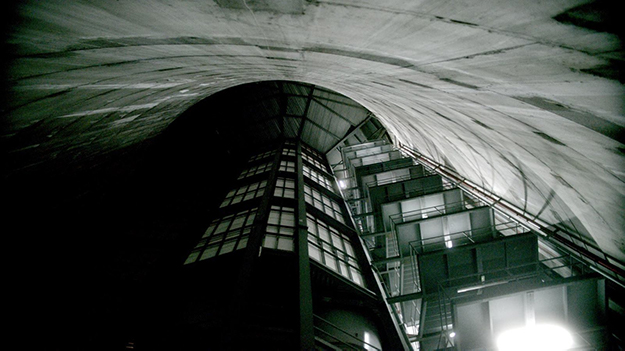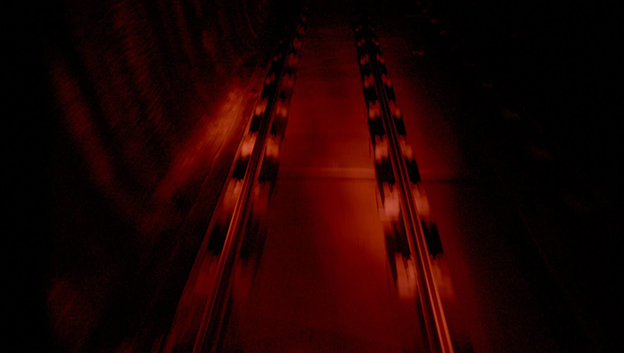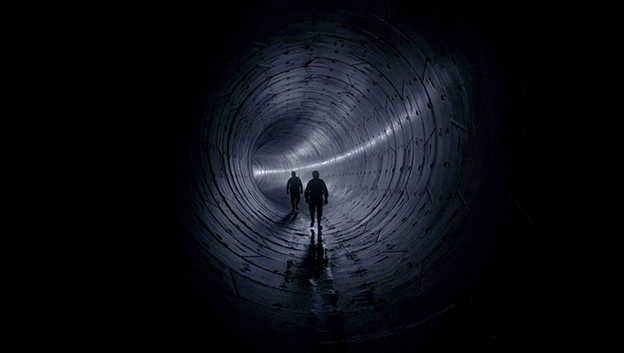Tunnel Vision: The Hidden City and City Symphonies
The Hidden City screens Wednesday, February 6 at Film Society of Lincoln Center as part of Film Comment Selects

The Hidden City (Victor Moreno, 2018)
The train and the movie camera were lovers from the start. The best-remembered of the “actualities” in the Lumière Brothers’ first program of projected films in 1895 recorded a train pulling into a station—allegedly causing audience members to faint or flee, though it does not even approach the viewer head-on, but cuts diagonally across the screen, rolling to a gentle halt. It wasn’t long before early cameras, too big and unwieldy to be easily moved, were being placed at the front of locomotives traveling through scenic landscapes. The effect of the resulting films is not so much like being on a train as it is like being a train, swallowing up the tracks as you hurtle through space. And it is impossible to see the rails spooling under the wheels without thinking of the film strip running through the projector, frame by frame instead of tie by tie, sprocket holes engaging instead of driving-wheels churning, but the same linear, flowing movement. “Cinema can be imagined as a hybrid of railroad and photography,” Rebecca Solnit wrote in her superb book River of Shadows: Eadweard Muybridge and the Technological Wild West. She suggests that railroads, born around the same time as still photography, “prepared viewers for the kinds of visual experience that cinema would make ordinary, it had adjusted people to a pure visual experience stripped of smell, sound, threat, tactility, and adjusted them to a new speed of encounter, the world rushing by the windows.”
In January 2019, the Museum of Modern Art presented two programs of Biograph films made between 1897 and 1901, one presented by the British Film Institute and the other from MoMA’s own collection. Shot on large-format 68mm negatives and at a much higher frame rate than other early films, these very brief vignettes have a staggering clarity and richness of detail. Many of them were shot from the front of trains, traveling through Welsh mountains, Colorado gold-mining territory, or London aboard a brand-new streetcar on a summer afternoon. Most astounding of all was a film shot in Germany from an elevated, suspended tram, floating underneath the rails, gliding past wedding-cake buildings and curving over a glittering river—giving a sensation of flying that could hardly be bettered by 3D or VR. Countless railroad films have followed in the footsteps (or tracks) of these primal spectacles, all exploiting the natural harmony of rails and camera, from Buster Keaton’s The General (1926) to D.A. Pennebaker’s Daybreak Express (1953) to The Taking of Pelham One Two Three (1974). But it was the Biograph films, fresh in my mind, that I thought of when I saw The Hidden City (2018), Victor Moreno’s hypnotic exploration of the subterranean labyrinth beneath Madrid, which includes scenes where the camera zooms through dark tunnels—sometimes at the front of a train and sometimes at the back, so the rails spin out in the murk like a crimson thread, and the walls recede into a vortex.

The Hidden City (Victor Moreno, 2018)
Spelunking through storm drains, sewers, buried power cables, and subway tunnels, The Hidden City reveals an alien world that suggests outer space, a realm where time, light, color, sound, and gravity all function differently. The film is not quite like anything you’ve seen before, yet it falls nobly within the tradition of the City Symphony, a genre that was spawned by the newness and strangeness of modern cities, pushing cinema technology to its limits in an effort to capture an experience too big or too fragmented for anyone to grasp. (Anthology Film Archives is midway through a magnificent, two-part series, “City Symphonies,” in conjunction with the new book The City Symphony Phenomenon: Cinema, Art, and Urban Modernity Between the Wars, edited by Steven Jacobs, Anthony Kinik, and Eva Hielscher.) The term was coined in 1927 by Walter Ruttman’s Berlin, Symphony of a Great City, but the genre existed well before that, going back to lyrical documentaries like Paul Strand and Charles Sheeler’s Manhatta (1921). What these films offered was a way of seeing the city that the human eye could not provide: through montage, superimposition, alterations of time, worm’s eye or bird’s eye views. Dziga Vertov, whose Man with a Movie Camera (1929) is another classic of the genre, introduced the idea of the camera as a kind of alien witness: “I am kino-eye, I am a mechanical eye. I, a machine, show you the world as only I can see it.” City symphonies are driven by the idea that, in some sense, all cities are hidden from full understanding.
The Hidden City is a celebration of the mechanical eye. We see subway tunnels through the computer screen in the driver’s cab of a train, the dark space converted to swirling, psychedelic colors. We see night-vision, surveillance-camera shots of swarming cockroaches, rats, and a cat, its own night-vision eyes flashing in the blackness. Throughout the film, we are fooled into seeing one thing that turns out to be something else, the camera playing tricks on us. What appears to be a night sky twinkling with stars is gradually revealed to be faint glimmers of light on a wet rock wall. A sudden, startling cut to an outdoor landscape of trees by a river—breathtaking after so long underground—proves to be a mural painted on the wall of a subway station. Dirt and debris spiraling slowly in waste-water look like distant galaxies. Feathery gray roots resemble strange sunless plants, perhaps seaweed.
The classic city symphonies of the 1920s were all silent, but they imitated music in their structures, evoking the rhythm and polyphony of the streets. Almost without music, and wordless after a brief, opening voice-over, The Hidden City uses sound in the same immersive but estranging way that it uses images. Environmental noises make up a minimalist score, alternating between the soothing (rain or rushing storm-water, the hum of wheels on rails, the whirring of wires) and the nerve-wracking (the relentless clatter of a rock-drill, the oddly stifling sound of someone breathing loudly through an oxygen mask). It is marked by abrupt shifts, as when the grating drill gives way to a near-silent scene of dust coiling up in a beam of light. The film is constructed around themes and variations, with recurring motifs defining the subterranean elements and spaces: the limitations of air and light, with some scenes illuminated only by headlamps or the sparks from construction; the ubiquity of water—dripping, sloshing, churning, sitting stagnant. The endless, snaking tunnels burrowing into the screen are measured by the whooshing speed of a train or the slow trudging pace of workmen.

The Hidden City (Victor Moreno, 2018)
Tunnels, in cinema, are usually settings for high drama: Orson Welles being chased through the glistening, vaulted and tiled Vienna sewers in The Third Man (1949)—a scene alluded to in The Hidden City by a shot straight up through a street grate like the one Welles’s Harry Lime tries to escape through—or Richard Basehart being chased through the Los Angeles storm drains in He Walked by Night (1948), where cinematographer John Alton has a field day with effects like a box of light that dwindles to a point as police run down the square concrete tunnels with their flashlights. There is no such excitement in The Hidden City, though there are glimmers of humor arising from the sheer imbalance of scale between humans and the underground realm they have carved out. A man climbs a twisting metal staircase that rises in a vast, cavernous space; he climbs and climbs, and the camera mutely climbs with him, and with each landing the plodding of his feet gets a little heavier, as the stairs are revealed to be infinite.
City symphonies treat the metropolis as an organism, trying to capture the ebb and flow of life in the streets, the rhythms of different times of day, the hidden processes that keep cities going. For instance, Prague by Night (1928), screened at Anthology in a program of urban nocturnes, shows not just resplendent shop-windows and floodlit buildings but graveyard-shift workers sorting mail, setting type, washing down the streets, fixing streetcar tracks in the rain, setting up a street market in the misty dawn. Markt in Berlin (1929) uses time-lapse photography to capture the setting up and breaking down of an open-air market at the beginning and end of the day, so that it seems as organic as the blooming and withering of a flower.
The charm of city symphonies lies partly in a sense of continuity. In every era, they have used the cutting edge of technology to capture what could not previously be captured, as Clemens Klopfenstein’s Story of Night, in 1979, exploited new highly sensitive black-and-white film stock to shoot night scenes with only available light, creating a dreamlike excursion through the cities of Europe from dusk to dawn. But they also return again and again to certain irresistible motifs, like the floating collage of electric signs that appears in every film that has ever tried to evoke urban night life, up to and including William Klein’s color-saturated masterpiece Broadway by Light (1958). Or like the camera traveling along train tracks, as pure and potent a cinematic experience in The Hidden City as it was more than a hundred years ago, a ride that never comes to an end.
Imogen Sara Smith is the author of In Lonely Places: Film Noir Beyond the City and Buster Keaton: The Persistence of Comedy, and has written for The Criterion Collection and elsewhere. Phantom Light is her regular column for Film Comment.







